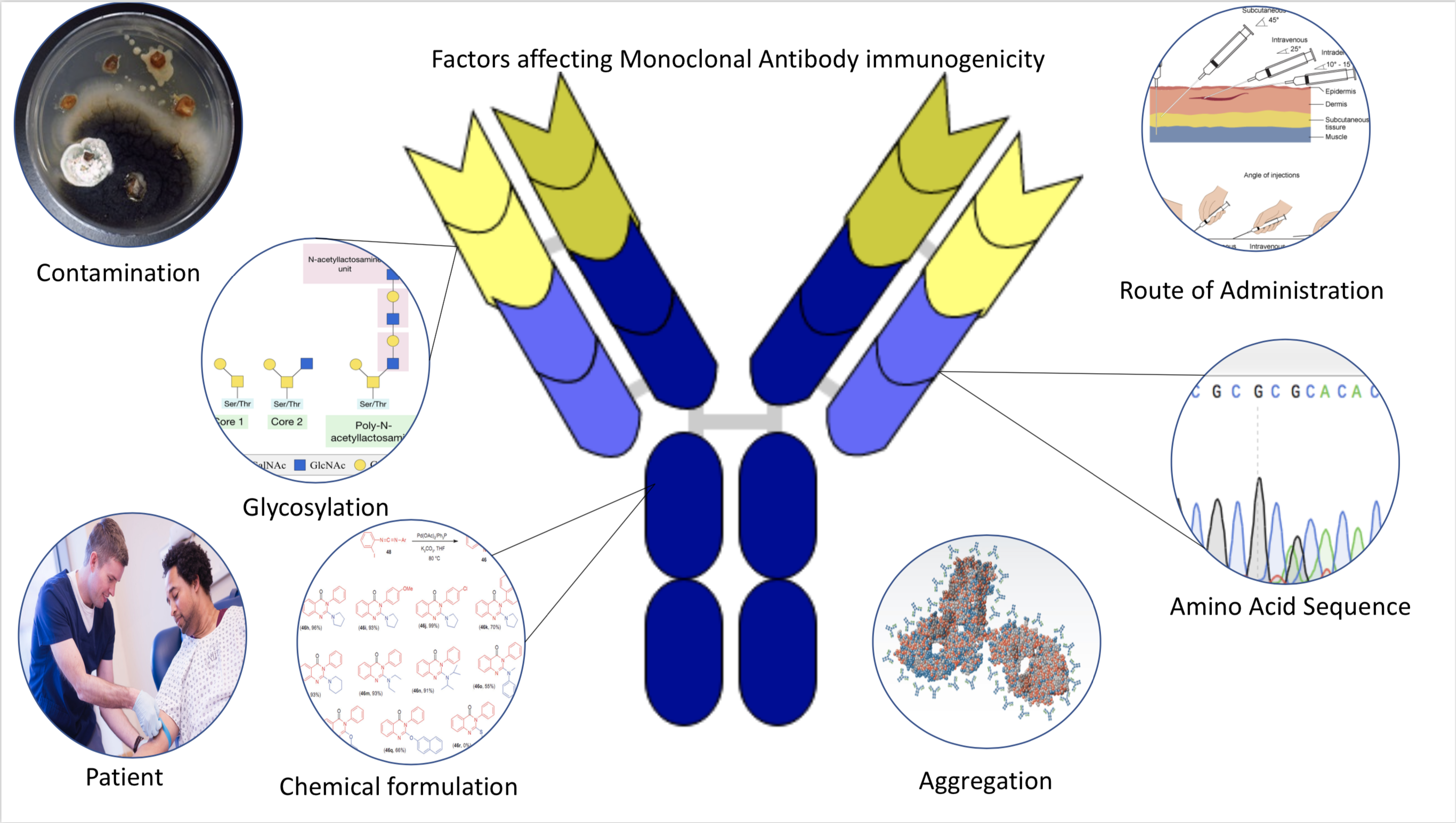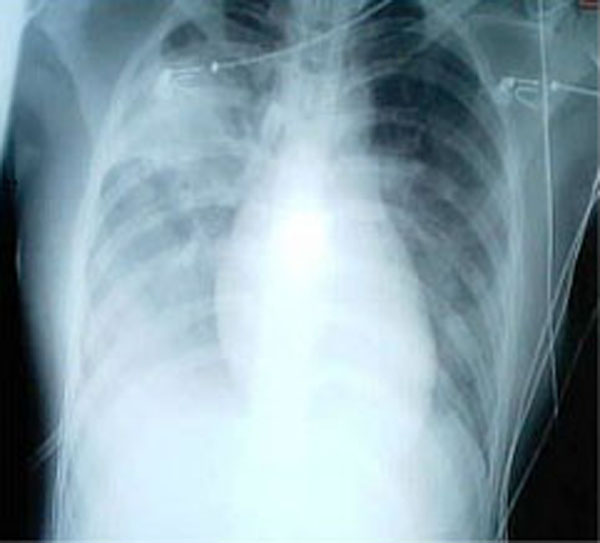|
Coronavirus Spike Protein
Spike (S) glycoprotein (sometimes also called spike protein, formerly known as E2) is the largest of the four major structural proteins found in coronaviruses. The spike protein assembles into trimers that form large structures, called spikes or peplomers, that project from the surface of the virion. The distinctive appearance of these spikes when visualized using negative stain transmission electron microscopy, "recalling the solar corona", gives the virus family its main name. The function of the spike glycoprotein is to mediate viral entry into the host cell by first interacting with molecules on the exterior cell surface and then fusing the viral and cellular membranes. Spike glycoprotein is a class I fusion protein that contains two regions, known as S1 and S2, responsible for these two functions. The S1 region contains the receptor-binding domain that binds to receptors on the cell surface. Coronaviruses use a very diverse range of receptors; HCoV-NL63, SARS-CoV ( ... [...More Info...] [...Related Items...] OR: [Wikipedia] [Google] [Baidu] |
Membrane Fusion Protein
Membrane fusion proteins (not to be confused with chimeric or fusion proteins) are proteins that cause fusion of biological membranes. Membrane fusion is critical for many biological processes, especially in eukaryotic development and viral entry. Fusion proteins can originate from genes encoded by infectious enveloped viruses, ancient retroviruses integrated into the host genome, or solely by the host genome. Post-transcriptional modifications made to the fusion proteins by the host, namely addition and modification of glycans and acetyl groups, can drastically affect fusogenicity (the ability to fuse). Fusion in eukaryotes Eukaryotic genomes contain several gene families, of host and viral origin, which encode products involved in driving membrane fusion. While adult somatic cells do not typically undergo membrane fusion under normal conditions, gametes and embryonic cells follow developmental pathways to non-spontaneously drive membrane fusion, such as in placental fo ... [...More Info...] [...Related Items...] OR: [Wikipedia] [Google] [Baidu] |
Antibodies
An antibody (Ab) or immunoglobulin (Ig) is a large, Y-shaped protein belonging to the immunoglobulin superfamily which is used by the immune system to identify and neutralize antigens such as bacteria and viruses, including those that cause disease. Each individual antibody recognizes one or more specific antigens, and antigens of virtually any size and chemical composition can be recognized. Antigen literally means "antibody generator", as it is the presence of an antigen that drives the formation of an antigen-specific antibody. Each of the branching chains comprising the "Y" of an antibody contains a paratope that specifically binds to one particular epitope on an antigen, allowing the two molecules to bind together with precision. Using this mechanism, antibodies can effectively "tag" the antigen (or a microbe or an infected cell bearing such an antigen) for attack by cells of the immune system, or can neutralize it directly (for example, by blocking a part of a viru ... [...More Info...] [...Related Items...] OR: [Wikipedia] [Google] [Baidu] |
Immunogenic
Immunogenicity is the ability of a foreign substance, such as an antigen, to provoke an immune response in the body of a human or other animal. It may be wanted or unwanted: * Wanted immunogenicity typically relates to vaccines, where the injection of an antigen (the vaccine) provokes an immune response against the pathogen, protecting the organism from future exposure. Immunogenicity is a central aspect of vaccine development. * Unwanted immunogenicity is an immune response by an organism against a therapeutic antigen. This reaction leads to production of anti-drug-antibodies (ADAs), inactivating the therapeutic effects of the treatment and potentially inducing adverse effects. A challenge in biotherapy is predicting the immunogenic potential of novel protein therapeutics. For example, immunogenicity data from high-income countries are not always transferable to low-income and middle-income countries. Another challenge is considering how the immunogenicity of vaccines changes with ... [...More Info...] [...Related Items...] OR: [Wikipedia] [Google] [Baidu] |
Cell Tropism
Endothelial cell tropism or endotheliotropism is a type of tissue tropism or host tropism that characterizes an pathogen's ability to recognize and infect an endothelial cell. Pathogens, such as viruses, can target a specific tissue type or multiple tissue types. Like other cells, the endothelium, endothelial cell possesses several features that supports a productive viral infection a cell including, cell surface receptors, immune responses, and other virulence factors. Endothelial cells are found in various tissue types such as in the Capillary, capillaries, veins, and Artery, arteries in the human body. As endothelial cells line these blood vessels and critical networks that extend access to various human organ systems, the virus entry into these cells can be detrimental to virus spread across the host system and affect clinical course of disease. Understanding the mechanisms of how viruses attach, enter, and control endothelial functions and host responses inform infectious diseas ... [...More Info...] [...Related Items...] OR: [Wikipedia] [Google] [Baidu] |
Host Range
In biology and medicine, a host is a larger organism that harbours a smaller organism; whether a parasite, parasitic, a mutualism (biology), mutualistic, or a commensalism, commensalist ''guest'' (symbiont). The guest is typically provided with nourishment and shelter. Examples include animals playing host to parasitic worms (e.g. nematodes), cell (biology), cells harbouring pathogenic (disease-causing) viruses, or a Fabaceae, bean plant hosting mutualistic (helpful) Rhizobia, nitrogen-fixing bacteria. More specifically in botany, a host plant supplies nutrient, food resources to micropredators, which have an evolutionarily stable strategy, evolutionarily stable relationship with their hosts similar to ectoparasitism. The host range is the collection of hosts that an organism can use as a partner. Symbiosis Symbiosis spans a wide variety of possible relationships between organisms, differing in their permanence and their effects on the two parties. If one of the partners in an ... [...More Info...] [...Related Items...] OR: [Wikipedia] [Google] [Baidu] |
Viral Replication
Viral replication is the formation of biological viruses during the infection process in the target host cells. Viruses must first get into the cell before viral replication can occur. Through the generation of abundant copies of its genome and packaging these copies, the virus continues infecting new hosts. Replication between viruses is greatly varied and depends on the type of genes involved in them. Most DNA viruses assemble in the nucleus while most RNA viruses develop solely in cytoplasm. Viral production / replication Viruses multiply only in living cells. The host cell must provide the energy and synthetic machinery and the low-molecular-weight precursors for the synthesis of viral proteins and nucleic acids. Virus replication occurs in seven stages: # Attachment # Entry (penetration) # Uncoating # Replication # Assembly # Maturation # Release (liberation stage). Attachment It is the first step of viral replication. Some viruses attach to the cell membrane of th ... [...More Info...] [...Related Items...] OR: [Wikipedia] [Google] [Baidu] |
Fusion Peptide
Membrane fusion proteins (not to be confused with chimeric or fusion proteins) are proteins that cause fusion of biological membranes. Membrane fusion is critical for many biological processes, especially in eukaryotic development and viral entry. Fusion proteins can originate from genes encoded by infectious enveloped viruses, ancient retroviruses integrated into the host genome, or solely by the host genome. Post-transcriptional modifications made to the fusion proteins by the host, namely addition and modification of glycans and acetyl groups, can drastically affect fusogenicity (the ability to fuse). Fusion in eukaryotes Eukaryotic genomes contain several gene families, of host and viral origin, which encode products involved in driving membrane fusion. While adult somatic cells do not typically undergo membrane fusion under normal conditions, gametes and embryonic cells follow developmental pathways to non-spontaneously drive membrane fusion, such as in placental fo ... [...More Info...] [...Related Items...] OR: [Wikipedia] [Google] [Baidu] |
Angiotensin-converting Enzyme 2
Angiotensin-converting enzyme 2 (ACE2) is an enzyme that can be found either attached to the membrane of cells (mACE2) in the intestines, kidney, testis, gallbladder, and heart or in a soluble form (sACE2). Both membrane bound and soluble ACE2 are integral parts of the renin–angiotensin–aldosterone system (RAAS) that exists to keep the body's blood pressure in check. mACE2 is cleaved by the enzyme ADAM17 in a process regulated by substrate presentation. ADAM17 cleavage releases the extracellular domain creating soluble ACE2 (sACE2). ACE2 enzyme activity opposes the classical arm of the RAAS by lowering blood pressure through catalyzing the hydrolysis of angiotensin II (a vasoconstrictor peptide which raises blood pressure) into angiotensin (1–7) (a vasodilator). Angiotensin (1-7) in turns binds to MasR receptors creating localized vasodilation and hence decreasing blood pressure. This decrease in blood pressure makes the entire process a promising drug target for tre ... [...More Info...] [...Related Items...] OR: [Wikipedia] [Google] [Baidu] |
COVID-19
Coronavirus disease 2019 (COVID-19) is a contagious disease caused by the coronavirus SARS-CoV-2. In January 2020, the disease spread worldwide, resulting in the COVID-19 pandemic. The symptoms of COVID‑19 can vary but often include fever, fatigue, cough, breathing difficulties, anosmia, loss of smell, and ageusia, loss of taste. Symptoms may begin one to fourteen days incubation period, after exposure to the virus. At least a third of people who are infected asymptomatic, do not develop noticeable symptoms. Of those who develop symptoms noticeable enough to be classified as patients, most (81%) develop mild to moderate symptoms (up to mild pneumonia), while 14% develop severe symptoms (dyspnea, hypoxia (medical), hypoxia, or more than 50% lung involvement on imaging), and 5% develop critical symptoms (respiratory failure, shock (circulatory), shock, or organ dysfunction, multiorgan dysfunction). Older people have a higher risk of developing severe symptoms. Some complicati ... [...More Info...] [...Related Items...] OR: [Wikipedia] [Google] [Baidu] |
SARS-CoV-2
Severe acute respiratory syndrome coronavirus 2 (SARS‑CoV‑2) is a strain of coronavirus that causes COVID-19, the respiratory illness responsible for the COVID-19 pandemic. The virus previously had the Novel coronavirus, provisional name 2019 novel coronavirus (2019-nCoV), and has also been called human coronavirus 2019 (HCoV-19 or hCoV-19). First identified in the city of Wuhan, Hubei, China, the World Health Organization designated the outbreak a public health emergency of international concern from January 30, 2020, to May 5, 2023. SARS‑CoV‑2 is a positive-sense single-stranded RNA virus that is Contagious disease, contagious in humans. SARS‑CoV‑2 is a strain of the species ''Betacoronavirus pandemicum'' (SARSr-CoV), as is SARS-CoV-1, the virus that caused the 2002–2004 SARS outbreak. There are animal-borne coronavirus strains more closely related to SARS-CoV-2, the most closely known relative being the BANAL-52 bat coronavirus. SARS-CoV-2 is of Zoonosis, z ... [...More Info...] [...Related Items...] OR: [Wikipedia] [Google] [Baidu] |
SARS
Severe acute respiratory syndrome (SARS) is a viral respiratory disease of zoonotic origin caused by the virus SARS-CoV-1, the first identified strain of the SARS-related coronavirus. The first known cases occurred in November 2002, and the syndrome caused the 2002–2004 SARS outbreak. In 2004, Xue Wu Zhang and Yee Leng Yap found that the Spike 2 (S2) protein of SARS is structurally similar to HIV-1 gp41 subunit, suggesting an analogous membrane fusion mechanism between the two. In the 2010s, Chinese scientists traced the virus through the intermediary of Asian palm civets to cave-dwelling horseshoe bats in Xiyang Yi Ethnic Township, Yunnan.The locality was referred to be "a cave in Kunming" in earlier sources because the Xiyang Yi Ethnic Township is administratively part of Kunming, though 70 km apart. Xiyang was identified on * For an earlier interview of the researchers about the locality of the caves, see: SARS was a relatively rare disease; at the end of the ep ... [...More Info...] [...Related Items...] OR: [Wikipedia] [Google] [Baidu] |





